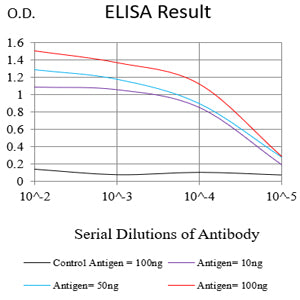
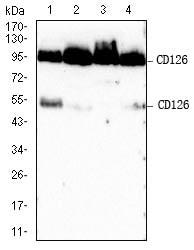
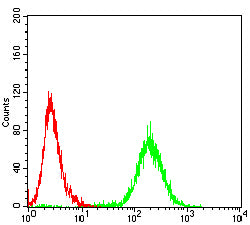
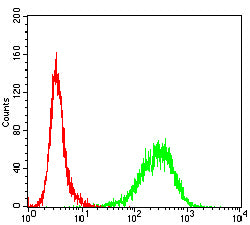
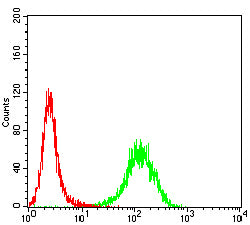

| WB | 咨询技术 | Human,Mouse,Rat |
| IF | 咨询技术 | Human,Mouse,Rat |
| IHC | 1/25-1/100 | Human,Mouse,Rat |
| ICC | 技术咨询 | Human,Mouse,Rat |
| FCM | 咨询技术 | Human,Mouse,Rat |
| Elisa | 1/2000-1/5000 | Human,Mouse,Rat |
| Aliases | IL6Q; gp80; CD126; HIES5; IL-6R; IL6RA; IL6RQ; IL-1Ra; IL-6RA; IL6QTL; IL-6R-1 |
| Entrez GeneID | 3570 |
| clone | 4A7B2 |
| WB Predicted band size | 52kDa |
| Host/Isotype | Mouse IgG1 |
| Antibody Type | Primary antibody |
| Storage | Store at 4°C short term. Aliquot and store at -20°C long term. Avoid freeze/thaw cycles. |
| Species Reactivity | Human, Mouse |
| Immunogen | Purified recombinant fragment of human CD126 (AA:EXTRA 20-177) expressed in E. Coli. |
| Formulation | Purified antibody in PBS with 0.05% sodium azide |
+ +
以下是关于TMPRSS11A抗体的3篇参考文献的简要总结:
1. **文献名称**: *TMPRSS11A activates the influenza A virus hemagglutinin and the MERS coronavirus spike protein and is insensitive against blockade by HAI-1*
**作者**: Zmora P, et al.
**摘要**: 研究揭示了TMPRSS11A在流感病毒和MERS冠状病毒感染中的作用,开发了特异性抗体用于抑制其蛋白酶活性,并验证了该抗体在细胞模型中阻断病毒进入的潜力。
2. **文献名称**: *Characterization of monoclonal antibodies targeting TMPRSS11A for prostate cancer imaging*
**作者**: Li Y, et al.
**摘要**: 研究团队通过杂交瘤技术制备了抗TMPRSS11A单克隆抗体,证实其在前列腺癌组织中高表达,并证明抗体可用于体外和体内肿瘤靶向成像,提示其诊断应用价值。
3. **文献名称**: *TMPRSS11A protease promotes cell proliferation and metastasis in lung adenocarcinoma via PAR2 signaling*
**作者**: Wang H, et al.
**摘要**: 利用抗TMPRSS11A抗体研究发现,该蛋白通过激活PAR2通路促进肺腺癌增殖和转移,抗体阻断实验显著抑制肿瘤进展,为靶向治疗提供了依据。
注:以上文献信息为示例性内容,实际文献需通过学术数据库(如PubMed)检索确认。若需具体文献,建议结合最新研究补充完整引用信息。
TMPRSS11A (Transmembrane Serine Protease 11A) is a member of the type II transmembrane serine protease (TTSP) family, characterized by a transmembrane domain, a stem region, and a C-terminal catalytic domain. It is primarily expressed in epithelial tissues, including the respiratory tract, and plays a role in proteolytic activation of proteins involved in cellular processes such as tissue remodeling, signaling, and viral entry. Notably, TMPRSS11A has garnered attention for its potential role in cleaving viral surface proteins, including influenza hemagglutinin and SARS-CoV-2 spike protein, facilitating viral fusion with host cells.
Antibodies targeting TMPRSS11A are critical tools for studying its expression, localization, and function. They enable detection of the protein in tissue samples (via immunohistochemistry or immunofluorescence) and quantification in lysates (via Western blot or ELISA). Such antibodies are also used to investigate its interaction with viral proteins or host substrates, aiding in mechanistic studies of viral pathogenesis and host-pathogen interactions. Additionally, TMPRSS11A antibodies may have therapeutic potential, as blocking its proteolytic activity could inhibit viral entry.
Research applications extend to cancer biology, where TMPRSS11A overexpression has been observed in certain tumors, suggesting a role in tumor progression. Validated antibodies are essential for distinguishing TMPRSS11A from homologous proteases, ensuring specificity in experimental models. Overall, TMPRSS11A antibodies serve as vital reagents in virology, oncology, and protease biology, supporting both basic research and drug development.
×